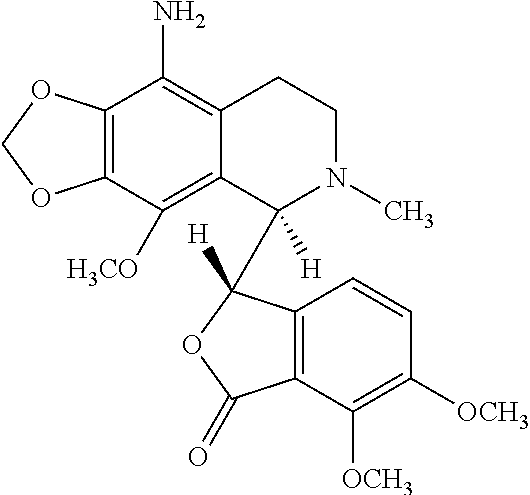9-aminonoscapine and its use in treating cancers, including drug-resistant cancers
a technology of aminonoscapine and 9-aminonoscapine, which is applied in the field of 9-aminonoscapine, to achieve the effect of effectively inhibiting cell proliferation and halting cell cycle progression
- Summary
- Abstract
- Description
- Claims
- Application Information
AI Technical Summary
Benefits of technology
Problems solved by technology
Method used
Image
Examples
example 1
Tubulin Binding Assay (Measurement of Dissociation Constant (Kd) of Noscapine and 9-Aminonoscapine with Tubulin)
[0088]Noscapine and 9-aminonoscapine (0-150 μM) were incubated with 2 μM tubulin in 25 mM PIPES, pH 6.8, 3 mM MgSO4, and 1 mM EGTA for 30 min at 25° C. The fluorescence intensities of tubulin in the absence and presence of different concentrations of the agents were monitored in a JASCO FP-6500 spectrofluorometer (JASCO, Tokyo, Japan) using a cuvette of 0.3-cm path length.
[0089]The excitation wavelength was 295 nm. The inner filter effects were corrected using a formula:
Fcorrected−Fobserved=antilog[(Aex−Aem) / 2],
[0090]where Aex and Aem are the absorbance at the excitation and emission wavelengths.
[0091]The dissociation constant (Kd) was estimated using the following equation.
ΔF=ΔFmaxL / (Kd+L)
[0092]where, ΔF is change in the fluorescence intensity of the tubulin upon binding to noscapine or 9-aminonoscapine, ΔFmax is the maximum change in the fluorescence intensity of the pro...
PUM
 Login to View More
Login to View More Abstract
Description
Claims
Application Information
 Login to View More
Login to View More - R&D
- Intellectual Property
- Life Sciences
- Materials
- Tech Scout
- Unparalleled Data Quality
- Higher Quality Content
- 60% Fewer Hallucinations
Browse by: Latest US Patents, China's latest patents, Technical Efficacy Thesaurus, Application Domain, Technology Topic, Popular Technical Reports.
© 2025 PatSnap. All rights reserved.Legal|Privacy policy|Modern Slavery Act Transparency Statement|Sitemap|About US| Contact US: help@patsnap.com



